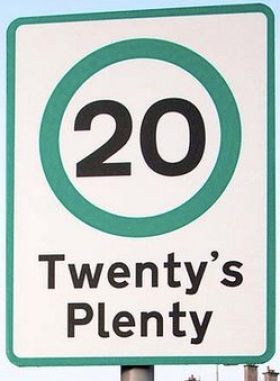
at Velo Cult last night.
(Photo © J. Maus/BikePortland)
The Bicycle Transportation Alliance has embarked on their 2013 legislative campaign. Last night they revealed that the three bills they plan to lobby for center around funding, speed limits, and enforcement.
The bills are substantial and they mark a full-force return to lobbying in Salem after the BTA opted to lay low and rebuild relationships with legislators in the 2011 session.
At a BTA-hosted happy hour event at Velo Cult Bike Shop last night, Advocacy Director Gerik Kransky shared that their “three-pronged approach” is “all about safety.”
Their flagship bill is the Safe Neighborhood Streets Act of 2013 that would give all cities in Oregon the authority to lower speed limits on neighborhood streets from 25 mph (the current default) to 20 mph. You might recall that the City of Portland successfully lobbied for a speed limit reduction law in the 2011 session. The City won authority to lower speed limits to 20 mph only on streets where safe biking and walking infrastructure has been added (like neighborhood greenways).

common throughout the UK.
(Photo: 20’s Plenty for Us)
The BTA bill, “Would be expanding on the ’20’s plenty’ concept,” said Kransky last night. “We’re saying 20’s plenty in the neighborhoods where people live and children play.” (Note: 20’s Plenty is an advocacy movement that covers much of the U.K. and other parts of Europe.)
Kransky said he doesn’t expect much opposition to the bill. “There are not a lot of reasons to oppose reductions in speed when it comes to safety, especially on neighborhood streets where we feel it should be more of a public space.”
Another bill the BTA will push for that’s related to speed is expected to be a much heavier lift. Kransky said they’re putting together a bill that would expand the concept of “remote enforcement.” The idea would be similar to existing red-light cameras in that no police officer would need to be present. Current Oregon law allows photo radar vans to be set up; but they must have an officer inside them and they can only be used four hours at a time. The BTA bill will seek to expand existing Oregon law to make unmanned photo radar cameras legal. The idea would be to place these cameras on “high-crash corridors” — larger arterial streets where data shows a high number of crashes and/or high speeds.
In addition to these speed-related bills, the BTA is also working on a bill that would increase funding for “non-roadway” bike paths/trails, sidewalks, and transit operations (as opposed to capital infrastructure) projects. The bill is called Connect Oregon Plus and it’s based on the existing Connect Oregon program administered by the Oregon Department of Transportation. Connect Oregon (also known as the Multimodal Transportation Fund) has been around since 2005 and is funded by state lottery-backed bonds. Historically, this pot of money was created to fund non-roadway projects that are not eligible for funding through the highway trust fund (gas tax). Unfortunately for bike advocates, biking and walking projects have never been eligible for Connect Oregon funds because the law only mentions “air, marine, rail, and public transit infrastructure improvements.” (I have been perplexed and frustrated for many years that bike projects are not listed!).
Back in 2009, bike advocates attempted to amend the language of the existing Connect Oregon law to add the words “non-motorized transportation” to the list of eligible projects; but they weren’t successful.
Connect Oregon has historically doled out about $100 million per biennium, so to convince existing interests to share that pot 50/50 with biking, walking, and transit projects will not be easy. That is, unless the BTA and their partners can help grow the overall pie considerably. Kransky says they’re seeking to expand the program to as much as $180 million and that if Connect Oregon Plus is successful, it would split that amount 50/50 among the existing project categores and the new, bike/walk/transit category.
Connect Oregon V, a bill that would continue the program in its current form, has already been introduced in the legislature and Kransky said that bill, “Will be our sparring mate as we have these conversations about Connect Oregon Plus.”
This is a full plate of lobbying for the BTA. In years past, they’ve had a staffer of their own down in Salem. This year (like last session), they’ve hired a contract lobbyist to work on their behalf and assist them in weaving through the legislative process. In addition to their three main bills, the BTA will undoubtedly also work to oppose bills that are not good for biking and they might assist on other bike-related bills as they arise.
The 2013 session starts the first week of February. Stay tuned for full coverage.

